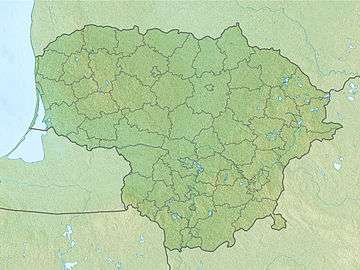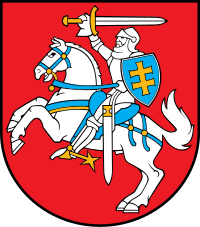Lithuanian Air Force
The Lithuanian Air Force or LAF (Lithuanian: Lietuvos karinės oro pajėgos (LK KOP)) is the military aviation branch of the Lithuanian armed forces. It is formed from professional military servicemen and non-military personnel. Units are located at Šiauliai military airfield near the city Šiauliai, at Radviliškis and Kaunas.
| Lithuanian Air Force | |
|---|---|
| Lietuvos karinės oro pajėgos | |
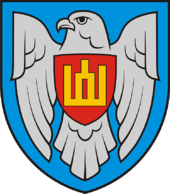 Lithuanian Air Force emblem | |
| Active | 1919–1940, 1992–present |
| Country | |
| Type | Air force |
| Role | Aerial warfare |
| Size | About 1,000 professional military servicemen and non-military personnel; 14 aircraft in its inventory. |
| Part of | Lithuanian Armed Forces |
| Garrison/HQ | Gedimino 25, LT-44319 Kaunas |
| Anniversaries | 12 March 1919 2 January 1991 |
| Commanders | |
| Commander | Colonel Dainius Guzas |
| Notable commanders | Brigadier General Antanas Gustaitis |
| Insignia | |
| Roundel |  |
| Aircraft flown | |
| Attack | L-39ZA |
| Multirole helicopter | Mi-8MTV-1, Mi-8T, Mi-8PS, AS365 |
| Transport | C-27J, L-410, |
History
1919–1940
After the declaration of Lithuania to be an independent state on February 16, 1918, the most urgent task of the new government was to organize a military force that could repel enemy armies that were coming from all sides. The first order for the creation of a Lithuanian army came on November 23, 1918.
In January 1919, an Engineering Company was formed within the military, which contained an Aviation Squad.[1] On March 12, 1919, the group was reorganized into an Aviation Company and became an independent military unit. Its leader was appointed to be marine engineer officer Petras Petronis. This date is considered to be the birthday of the Lithuanian Air Force.
Between March and December 1919 and between 1932 and 1940, the Kaunas Military Aviation School operated in that city. The school trained officers in many aviation disciplines: pilots, observers, gunners and mechanics.
The first aircraft (Sopwith 1½ Strutter) was taken by the Lithuanian military from the Red Army, on February 5, 1919, at the city of Jieznas. On February 27, 1919, eight new reconnaissance aircraft, LVG C.VI, were received. They had been purchased in Germany. In June, five more aircraft were purchased. In the following years some aircraft were taken as war booty and repaired in Lithuanian Aviation workshops, many were purchased from various countries and a number were built by native designers Jurgis Dobkevičius and Antanas Gustaitis.
The Lithuanian Military Aviation was active in battles with the Red Army and Polish military units. The pilot performing the most military sorties was Jurgis Dobkevičius, who later became the first Lithuanian aircraft designer and builder. On May 12, 1920, Vytautas Rauba was the first Lithuanian aviator to lose his life in an aircraft crash. On October 4 of the same year, in a fight with the Polish military, the first aircraft with a Lithuanian crew was shot down. The pilot of the aircraft, Juozas Kumpis, leader of Lithuania's First Air Squadron, was severely injured and died as prisoner of the Polish military.
Starting in 1920 the military aviation branch was renamed a number of times and some time after 1928 it was named to the equivalent of the Lithuanian Air Force.
The Lithuanian Air Force supported and encouraged various aeronautics related activities, such as the sport of gliding. In 1933, in cooperation with Aero Club of Lithuania, they helped establish a Lithuanian Gliding School in Nida and send their only experienced glider pilot, Gregorius Radvenis, to be the school's instructor and supervisor.
In 1940, the Lithuanian Air Force consisted of eight Air Squadrons, including reconnaissance, fighter, bomber and training units. Air Force bases had been established in the cities and towns of Kaunas /Žagariškės, Šiauliai /Zokniai (Zokniai airfield), Panevėžys /Pajuostis. In the summer time, airports in the cities of Palanga and Rukla were also used. A total of 117 aircraft and 230 pilots and observers were listed in the books at that time.
After 1992
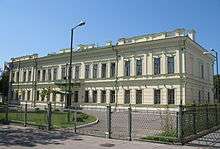
On 23 January 1992, the Minister of Defense signed an order establishing the staff for the Aviation Base of the Aviation Service. But an actual base in the Šiauliai airport territory (Barysiai airfield) was not established until March, when according to the ordinance of the Government of Lithuanian Republic, all the infrastructure, buildings, territory and 24 An-2 aircraft were passed from ”Lithuanian Airlines" to the Aviation Service of the Ministry of Defense in January 1992.
On 12 June 1992, the first time after regaining the independence of Lithuania, An-2 aircraft, marked with the double cross of Vytis on its wings – the distinguishing sign of Lithuanian Air Force – took off from Barysiai airfield. This date is considered to be the Aviation Base foundation date. In February 1993 four L-39C Albatros aircraft were brought from Kyrgyzstan.
After 1 March 1993 Aviation Service was reformed to the Lithuanian Air Force and Aviation Base was renamed the First Aviation Base of the Lithuanian Air Force. In January 1994 Lithuania officially applied for NATO membership. From 1995 to 1999, according to a decree of Lithuanian Government the First Aviation Base was relocated to Zokniai airfield nearby Šiauliai, which was used for fighter wing, radio-electronic fight and reconnaissance squadrons dislocation during the Soviet occupation.
According to the decree of the Minister of Defense of the Republic of Lithuania Linas Linkevičius, the First Aviation Base and the Second Aviation Base were reorganized into the Lithuanian Air Force Aviation Base as of 1 October 2004. Up to 2004, there were only light attack jet aircraft and transport aircraft located at the Air Base, after the reconstruction of First and Second Air Bases, helicopters are located at the Air Base too.
Structure
The Lithuanian Air Force Headquarters and the Airspace Surveillance and Control Command are located in Kaunas, while the Air Space Control Centre and the Baltic Air Surveillance Network's Regional Airspace Surveillance Coordination Centre (RASCC) are located nearby in Karmėlava. Air Base, and Air Force Armament and Equipment Repair Depot are located at Šiauliai Air Base. The Air Defence Battalion, formed in 2000, is located in Radviliškis.
Air Base
The main air base is located in Šiauliai city. It is manned with professional military and also non-military personnel. It consists of a headquarters, air operation group and operational support group. The base operates various fixed wing and rotary blade aircraft.[2] The staff, aircraft and equipment of the Air Base has participated in many international training missions abroad and at home. Main tasks of the Air Base are:
- Host nation Support for NATO Baltic Air Policing forces;
- Search and Rescue;
- Passenger, cargo and VIP transport;
- Air medical evacuation;
- Personnel deployment;
- Army and Navy air support;
- Air base personnel combat readiness training.
Air Defence Battalion
.jpg)
The Air Defence Battalion’s primary missions include:
- Defend state facilities of vital importance against military aviation attacks from the air in low and medium altitude;
- Support land forces in fighting against ground armoured technical equipment and in other events;
- Train military personnel in carrying out combat tasks.
Development of infrastructure is one key missions of the Air Defence Battalion currently in the stage of development.
Airspace Surveillance and Control Command
The Airspace Surveillance and Control Command works closely with the Baltic States Air Surveillance System, BALTNET. The appropriate legal documentation of the BALTNET project was developed, the Reciprocal Memorandum of Understanding concerning military personnel training was signed among Lithuanian, Estonian, Latvian, and Danish Ministries of Defence. The Regional Air Spaces Surveillance Co-ordination Centre (RASSCC), headquarters of the BALTNET project, was established in the LTAF Airspace Control Centre and has been fully functioning since early 2000. Military personnel from all the three Baltic States serve as air surveillance operators at the centre and rotate according to national timetables. The Commander of the centre is appointed for two years and represents one of the Baltic States.
Armament and Equipment Repair Depot
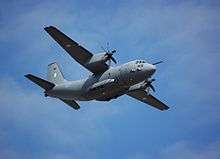
The main tasks of Armament and Equipment Repair Depot:
- To perform periodical works of maintenance as well as minor and medium repair of LAF armament and equipment outdoors;
- To modernize LAF equipment according to contemporary aviation needs and NATO standards;
- To prepare technical requirements for organizing competitions of centralized repair, modernization and purchasing of equipment;
- To perform periodical works of maintenance, supervision and repair of life-saving equipment used in search and rescue works;
- Under necessity, to perform works of maintenance and minor repair of special equipment of NATO partners, performing the function of air police in Lithuania. ;
- Under necessity to provide proper room for ensuring minor repair operations of airplanes (QRA) of NATO partners;
- Raise the level of military and professional staff preparation in order to be able in future perform periodic maintenance and repair of western type aircraft.
Baltic Air Policing
After Lithuania joined NATO organization back in 2004, its (alongside Latvia's and Estonia's) air space is protected by NATO. NATO members provide usually 4 fighter aircraft, based in Lithuania, to police the Baltic States’ airspace. The deployments rotate between NATO members (that started in March 2004 with Belgium Air Force F-16s) and most NATO members that operate fighters have made a deployment to Lithuania. The Baltic States are considering in the near future to protect their airspace on their own.
Modernisation
In line with the set priorities, the Lithuanian Air Force are implementing modernisation plans.
Since Independence in 1991, the Lithuanian Air force has bought 3 new C-27J Spartan military transport aircraft. They have replaced the older Soviet-era An-26.
In 2007, two L-39ZA aircraft underwent extension of technical resources in Romania. Maintenance works included exhaustive check-up of the aircraft units and major engine repairs. New navigation equipment GNS 530 was installed and radio communication sets changed in pilot cabins. These planes are used to train fighter control officers in air policing mission and fighter command officers.[3]
Furthermore, a complex program of capital overhaul, upgrade and modernisation of the Air Force's helicopters Mi-8 and twin engine short-range transport aircraft L-410 was conducted.[4][5] In 2013, three Eurocopter AS365 Dauphin search and rescue helicopters were ordered from France for roughly €52 million euros. The deal was financed by the EU and deliveries began in 2015.[6]
On October of 2019, Lithuanian armed forces announced that Lithuanian Air Force decided to buy 6 Sikorsky UH-60 Black Hawk helicopters from USA.
Aircraft
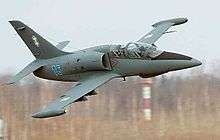
.jpg)
Current inventory
| Aircraft | Origin | Type | Variant | In service | Notes | |
|---|---|---|---|---|---|---|
| Combat Aircraft | ||||||
| Aero L-39 | Czech Republic | light attack | 1[7] | |||
| Transport | ||||||
| Cessna 172 | United States | utility | RG Cutlass | 1[8] | used for Special forces | |
| Alenia C-27J | Italy | transport | 3[7] | |||
| L-410 Turbolet | Czech Republic | transport | 2[7] | |||
| Helicopters | ||||||
| Mil Mi-17 | Russia | transport | 2[7] | |||
| Eurocopter AS365 | France | SAR / utility | AS365 N3 | 3[7] | ||
| Training | ||||||
| Aero L-39 | Czech Republic | light attack | L-39C | 3 | on lease from Latvia[9] | |
Note: Three C-17 Globemaster III's are available through the Heavy Airlift Wing based in Hungary.[10]
Retired aircraft
Previous aircraft operated by the Air Force consisted of the An-2 Colt, An-26 Curl, PZL-104 Wilga, and the Mil Mi-2 helicopter[11]
Ranks and insignia
Officers
The rank insignia for commissioned officers for the air force.
| NATO code | OF-10 | OF-9 | OF-8 | OF-7 | OF-6 | OF-5 | OF-4 | OF-3 | OF-2 | OF-1 | OF(D) | Student officer | ||||||||||||||||||||||||
|---|---|---|---|---|---|---|---|---|---|---|---|---|---|---|---|---|---|---|---|---|---|---|---|---|---|---|---|---|---|---|---|---|---|---|---|---|
| General officers (Generolai) | Senior officers (Vyresnieji karininkai) | Junior officers (Jaunesnieji karininkai) | ||||||||||||||||||||||||||||||||||
(Edit) |
No equivalent |
 |
 |
 |
 |
 |
 |
 |
 |
 |
No equivalent |  | ||||||||||||||||||||||||
| Generolas leitenantas | Generolas majoras | Brigados generolas | Pulkininkas | Pulkininkas leitenantas | Majoras | Kapitonas | Vyresnysis leitenantas | Leitenantas | Kariūnas | |||||||||||||||||||||||||||
| Limitation (as of 2012)[12] |
< 9 | < 30 | < 127 | < 375 | N/A | |||||||||||||||||||||||||||||||
| NATO code | OF-10 | OF-9 | OF-8 | OF-7 | OF-6 | OF-5 | OF-4 | OF-3 | OF-2 | OF-1 | OF(D) | Student officer | ||||||||||||||||||||||||
Enlisted
The rank insignia for enlisted personnel for the air force.
| NATO Code | OR-9 | OR-8 | OR-7 | OR-6 | OR-5 | OR-4 | OR-3 | OR-2 | OR-1 | |||||||||||||||||||||||||||
|---|---|---|---|---|---|---|---|---|---|---|---|---|---|---|---|---|---|---|---|---|---|---|---|---|---|---|---|---|---|---|---|---|---|---|---|---|
(Edit) |
 |
 |
 |
 |
 |
 |
 |
 |
 | |||||||||||||||||||||||||||
| Seržantas majoras | Viršila | Štabo seržantas | Vyresnysis seržantas | Seržantas | Grandinis | Vyresnysis eilinis | Eilinis | Jaunesnysis eilinis | ||||||||||||||||||||||||||||
| NATO Code | OR-9 | OR-8 | OR-7 | OR-6 | OR-5 | OR-4 | OR-3 | OR-2 | OR-1 | |||||||||||||||||||||||||||
See also
- Baltic Air Policing
- Air defence battalion
- Airspace Surveillance and Control Command
- Aviation Unit of State Border Guard Service
- List of airports in Lithuania
External links
| Wikimedia Commons has media related to Air force of Lithuania. |
References
As of this edit, this article uses content from "Lithuanian Air Force", which is licensed in a way that permits reuse under the Creative Commons Attribution-ShareAlike 3.0 Unported License, but not under the GFDL. All relevant terms must be followed.
Notes
- A.Gamziukas, G.Ramoška, Lithuanian Air Force 1919-1940, pg. 262 [Lietuvos Karinė Aviacija 1919-1940, Lietuvos aviacijos muziejus, Kaunas, 1999, ISBN 9986-557-12-7]
- "Air Base of the Lithuanian Air Force". kariuomene.kam.lt. Archived from the original on 21 June 2018. Retrieved 21 June 2018.
- "Air Force pilots fly L-39 ZA aircraft again (sic)". Archived from the original on 2011-07-16. Retrieved 2009-03-22.
- "Paieškos ir gelbėjimo darbus vykdys kapitaliai suremontuotas sraigtasparnis" (in Lithuanian). National Defence Ministry Republic of Lithuania.
- "Lithuanian manufacturers for the military" (PDF). National Defence Ministry Republic of Lithuania.
- "First of the Three SAR Helicopters Lithuania Had Purchased Arrived". defense-aerospace.com. 3 June 2015.
- "World Air Forces 2020". Flightglobal Insight. 2020. Retrieved 2 January 2020.
- "Special forces Cessna for Lithuanian Air Force". AirForces Monthly. Key Publishing. October 2019. p. 12.
- "Lietuvos kariuomenė iš latvių išsinuomojo tris lėktuvus". lietuvosdiena.lrytas.lt (in Lithuanian). Archived from the original on 20 June 2018. Retrieved 20 June 2018.
- "Heavy Airlift Wing". Strategic Airlift Capability Program. Retrieved 17 April 2020.
- "World Air Forces 2000 pg. 74". flightglobal.com. Archived from the original on 18 May 2015. Retrieved 11 May 2015.
- (in Lithuanian) Principinės kariuomenės struktūros 2012 metais, planuojamos principinės kariuomenės struktūros 2017 metais nustatymo, krašto apsaugos sistemos karių ribinių skaičių ir statutinių valstybės tarnautojų ribinio skaičiaus 2012 metais ir 2017 metais patvirtinimo įstatymas
Bibliography
- Humberstone, Richard. Lithuanian Air Force, 1918-1940 (Insignia Air Force Special No.1). London: Blue Rider Publishing, 1996.
